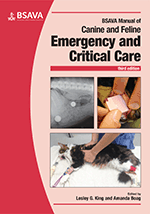
Full text loading...

The prognosis for shock is variable, from good to grave, depending on the underlying cause and clinical stage. However, even patients presenting with dramatic clinical signs may respond well to appropriate treatment. This chapter provides the reader with the tools to determine and administer appropriate treatment in cases of shock.
Assessment and treatment of shock, Page 1 of 1
< Previous page | Next page > /docserver/preview/fulltext/10.22233/9781910443262/9781910443262.3-1.gif

Full text loading...



